[ Return ]
Big Waitangi Day festival returns to Motueka
February 6th, 2011
[by David Armstrong]
A large and festive turnout to the Waitangi Day celebrations at Te Awhina marae today augers well for a return of this event to the Motueka calendar after five years of no local celebrations of New Zealand's founding day.
Well over 1000 people, including many visitors from other countries interested in New Zealand history, defied the scorching heat and high humidity - it nudgeded 35 degrees in the shade at 3pm - to visit the marae during the all-day festival. About 160 of them who had never been formally welcomed onto the marae took part in two powhiris at 11am and 2pm.
Such festive days were run regularly here on Waitangi Day until five years ago when they were dropped, but the marae decided this year to re-create the event as an educational and fun day for all people, as well as to raise some funds for furniture for their kitchen.
There was no formal ceremony such as those conducted at Waitangi and several other historic sites around the country, but rather the marae hosted a day of fun, food, sports and education with the option of experiencing and learning about marae protocols and the history of the day.
The large field behind the marae buildings was ringed with about 25 stalls selling kai and promoting community and marae services. The truck stage was on one side and the centre of the field was an area for playing sports, including the traditional Ki-o-Rahi game which is played in several countries overseas but rarely in Aotearoa.
Stage acts during the day included Tania Corbett singing a waiata, the Darnz hip hop group, dancing by Tongan and Cook Island groups, Lenny and Joe, The Wetbacks, Ralph Bennett-Eades and a reggae group.
For those looking for a greater understanding of the bicultural basis of our nation and what the day stands for, a highlight (and hot spot under the sun!) of the day was the guided powhiri. First Barney Thomas, representing the new visitors, explained what would happen and then the visitors were welcomed. The main speaker was Tom Matthews. About 120 people attended the first powhiri and around 30 the later one.
Speaking in te reo, Tom said the celebration of the day allowed the hurts of the past to be recognised, but then provided a way for the two founding cultures to come together and celebrate what we have now. Without the visitors to the marae, this would not be possible, he said. For Maori, having pakeha visitors at the marae allowed them to become more aware and understanding of the issues of the past, so they could assist iwi in the ongoing healing process.
Local members of parliament, Labour's Damien O'Connor and Maryanne Street, were also welcomed as part of the newcomers group, and both spoke of the importance of the day. Tasman District Mayor Richard Kempthorne sat with the kaumatua and also spoke briefly in welcome.
Later about 25 people sat in the wharenui and heard from three guest speakers. Neil Clifton, DOC's Nelson/Marlborough conservator, told of how the legislation under which DOC works required them to take into account the Crown's treaty partners, but in fact DOC's conservation work with iwi is a natural, day-to-day process anyway that doesn't need laws to force it. "DOC feels totally at home working with iwi on common conservation issues," he said.
"What makes New Zealand different to anyone else in the world? Two things. One is the unique physical environment, our landscape. The second is the Maori culture - no other country has that. Looking after both is therefore vital to the country's economic future."
Maryanne Street talked about the Treaty, and said that the settling of treaty grievances is now moving to co-management models which are set in law. She said the treaty makes our country unique. It is a founding document rather than an after-the-fact agreement between a colonising power and first-nation people.
"We need to find the things we have in common, not just the differences," she said. "One of them is the care of the land itself."
Barney Thomas gave illustrated examples of some of the local grievances which originated from the legal and administrative processes that the Crown and its agencies used to get around the problem of there not being enough land available in the Nelson/Tasman area for the European settlers.
Wakatu Inc, made up of the four district iwi including the two Motueka-based iwi, was set up to look after Maori interests previously managed by Crown agencies.
"New Zealand is a bloody good country that is so lucky compared with other countries overseas, so we rejoice in this day," he said. "And we rejoice that DOC looks after our old occupation sites and urupa with us, such as all the camping sites in the Abel Tasman National Park."
The marae was very pleased with the response to the festival. "Maybe the number of people coming here today could be the start of people coming here more often to the marae for other activities," said a spokesman.
|
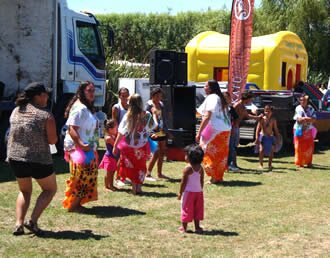
The Cook Island dancing group
|
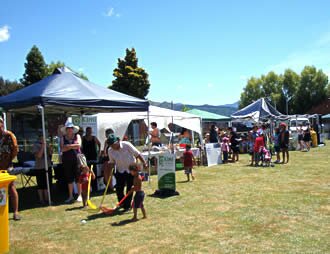
Some of the stalls
|
|
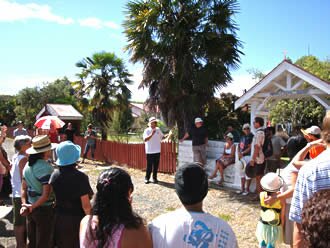
Barney Thomas prepares visitors for the powhiri
|
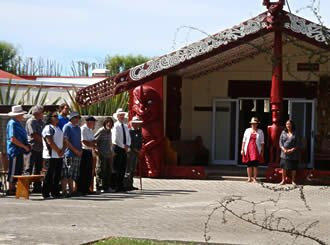
The visitors are called onto the marae
|
|
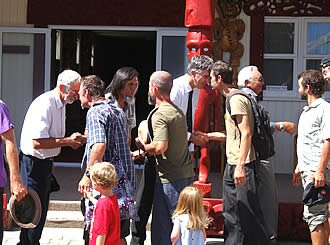
The welcome concludes with the hongi
|
|
>> , to be added to the page. [If this link doesn't work, use this form instead]
[ Return ]